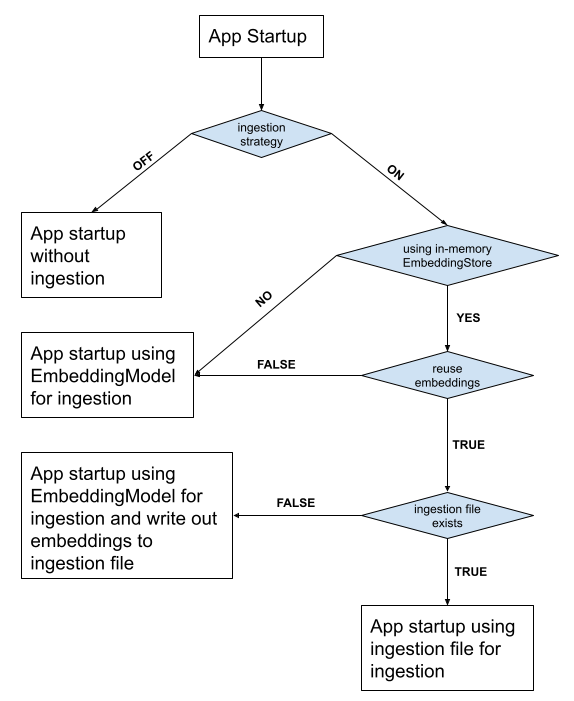Easy RAG: the easiest way to get started with Retrieval Augmented Generation
The Quarkus LangChain4j project provides a separate extension named
quarkus-langchain4j-easy-rag which provides an extremely easy way to get a
RAG pipeline up and running. After adding this extension to your
application, all that is needed to ingest documents into an embedding store
is to add a dependency that provides an embedding model, and provide a
single configuration property, quarkus.langchain4j.easy-rag.path, which
denotes a path in the local filesystem where your documents are stored. On
startup, Quarkus will automatically scan all files in the directory and
ingest them into an in-memory embedding store.
Apache Tika, a library for parsing various file formats, is used under the hood, so your documents can be in any of its supported formats (plain text, PDF, DOCX, HTML, etc.), including images with text, which will be parsed using OCR (OCR requires to have the Tesseract library installed in your system - see https://cwiki.apache.org/confluence/display/TIKA/TikaOCR).
You also don’t even need to add a persistent embedding store - the
quarkus-langchain4j-easy-rag extension will automatically register a
simple in-memory store for you if no other store is detected. You also don’t
have to provide an implementation of RetrievalAugmentor, a basic default
instance will be generated for you and wired to the in-memory store.
An in-memory embedding store is OK for very simple use cases and
getting started quickly, but is extremely limited in terms of scalability,
and the data in it is not stored persistently. When using Easy RAG, it is
still possible to use a persistent embedding store, such as Redis, by adding
the relevant extension (like quarkus-langchain4j-redis) to your
application.
|
You have to add an extension that provides an embedding model. For that, you
can choose from the plethora of extensions like
quarkus-langchain4j-openai, quarkus-langchain4j-ollama, or import an
in-process embedding model - these have the
advantage of not having to send data over the wire.
If you add two or more artifacts that provide embedding models,
Quarkus will ask you to choose one of them using the
quarkus.langchain4j.embedding-model.provider property.
|
Reusing embeddings
You might find that when doing local development that computing embeddings takes some time. This pain can often be felt in dev mode when it may take several minutes between restarts.
That’s where reusable ingestions come in! If you don’t configure a persistent embedding store and set
quarkus.langchain4j.easy-rag.reuse-embeddings.enabled=truethen the easy-rag extension will detect the local embeddings. If they exist then they are loaded into the embedding store. If they don’t exist, they are computed as normal and then written out to the file easy-rag-embeddings.json in the current directory.
You can customize the embeddings file by setting the quarkus.langchain4j.easy-rag.reuse-embeddings.file property.
|
See this diagram which describes the flow:

Getting started with a ready-to-use example
To see Easy RAG in action, use the project samples/chatbot-easy-rag in the
quarkus-langchain4j
repository. Simply clone the repository, navigate to
samples/chatbot-easy-rag, declare the QUARKUS_LANGCHAIN4J_OPENAI_API_KEY
environment variable containing your OpenAI API key and then start the
project using mvn quarkus:dev. When the application starts, navigate to
localhost:8080 and ask any questions that the bot can answer (look into
the files in samples/chatbot-easy-rag/catalog to see
what documents the bot has ingested). For example, ask:
What are the benefits of a standard savings account?
| This application contains an HTML+JavaScript based UI. But with Quarkus dev mode, it is possible to try out RAG even without having to write a frontend. If the application is in dev mode, simply open the Dev UI (http://localhost:8080/q/dev-ui) and click the 'Chat' button inside the LangChain4j card. A built-in UI for chatting will appear, and it will make use of the RAG pipeline created by the Easy RAG extension. More information about Dev UI features is on the Dev UI page. |
To control the parameters of the document splitter that ingests documents at startup, use the following properties:
-
quarkus.langchain4j.easy-rag.max-segment-size: The maximum length of a single document, in tokens. Default is 300. -
quarkus.langchain4j.easy-rag.max-overlap-size: The overlap between adjacent documents. Default is 30.
To control the number of retrieved documents, use
quarkus.langchain4j.easy-rag.max-results. The default is 5.
To control the path matcher denoting which files to ingest, use
quarkus.langchain4j.easy-rag.path-matcher. The default is glob:**,
meaning all files recursively.
For finer-grained control of the Apache Tika parsers (for example, to turn
off OCR capabilities), you can use a regular XML config file recognized by
Tika (see Tika
documentation), and specify -Dtika.config to point at the file.
Configuration
Several configuration properties are available:
Configuration property fixed at build time - All other configuration properties are overridable at runtime
Configuration property |
Type |
Default |
|---|---|---|
Path to the directory containing the documents to be ingested. This is either an absolute or relative path in the filesystem. A relative path is resolved against the current working directory at runtime. Environment variable: |
string |
required |
Matcher used for filtering which files from the directory should be ingested. This uses the Environment variable: |
string |
|
Whether to recursively ingest documents from subdirectories. Environment variable: |
boolean |
|
Maximum segment size when splitting documents, in tokens. Environment variable: |
int |
|
Maximum overlap (in tokens) when splitting documents. Environment variable: |
int |
|
Maximum number of results to return when querying the retrieval augmentor. Environment variable: |
int |
|
The minimum score for results to return when querying the retrieval augmentor. Environment variable: |
double |
|
The strategy to decide whether document ingestion into the store should happen at startup or not. The default is ON. Changing to OFF generally only makes sense if running against a persistent embedding store that was already populated. When set to MANUAL, it is expected that the application will inject and call the Environment variable: |
|
|
Whether or not to reuse embeddings. Defaults to Environment variable: |
boolean |
|
The file path to load/save embeddings, assuming Defaults to Environment variable: |
string |
|